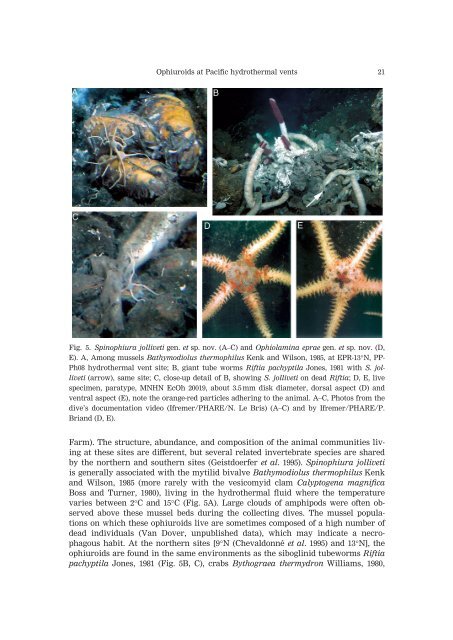from Hydrothermal Vents in the East Pacific - Station Biologique de ...
from Hydrothermal Vents in the East Pacific - Station Biologique de ...
from Hydrothermal Vents in the East Pacific - Station Biologique de ...
You also want an ePaper? Increase the reach of your titles
YUMPU automatically turns print PDFs into web optimized ePapers that Google loves.
Ophiuroids at <strong>Pacific</strong> hydro<strong>the</strong>rmal vents 21<br />
Fig. 5. Sp<strong>in</strong>ophiura jolliveti gen. et sp. nov. (A–C) and Ophiolam<strong>in</strong>a eprae gen. et sp. nov. (D,<br />
E). A, Among mussels Bathymodiolus <strong>the</strong>rmophilus Kenk and Wilson, 1985, at EPR-13°N, PP-<br />
Ph08 hydro<strong>the</strong>rmal vent site; B, giant tube worms Riftia pachyptila Jones, 1981 with S. jolliveti<br />
(arrow), same site; C, close-up <strong>de</strong>tail of B, show<strong>in</strong>g S. jolliveti on <strong>de</strong>ad Riftia; D, E, live<br />
specimen, paratype, MNHN EcOh 20019, about 3.5 mm disk diameter, dorsal aspect (D) and<br />
ventral aspect (E), note <strong>the</strong> orange-red particles adher<strong>in</strong>g to <strong>the</strong> animal. A–C, Photos <strong>from</strong> <strong>the</strong><br />
dive’s documentation vi<strong>de</strong>o (Ifremer/PHARE/N. Le Bris) (A–C) and by Ifremer/PHARE/P.<br />
Briand (D, E).<br />
Farm). The structure, abundance, and composition of <strong>the</strong> animal communities liv<strong>in</strong>g<br />
at <strong>the</strong>se sites are different, but several related <strong>in</strong>vertebrate species are shared<br />
by <strong>the</strong> nor<strong>the</strong>rn and sou<strong>the</strong>rn sites (Geistdoerfer et al. 1995). Sp<strong>in</strong>ophiura jolliveti<br />
is generally associated with <strong>the</strong> mytilid bivalve Bathymodiolus <strong>the</strong>rmophilus Kenk<br />
and Wilson, 1985 (more rarely with <strong>the</strong> vesicomyid clam Calyptogena magnifica<br />
Boss and Turner, 1980), liv<strong>in</strong>g <strong>in</strong> <strong>the</strong> hydro<strong>the</strong>rmal fluid where <strong>the</strong> temperature<br />
varies between 2°C and 15°C (Fig. 5A). Large clouds of amphipods were often observed<br />
above <strong>the</strong>se mussel beds dur<strong>in</strong>g <strong>the</strong> collect<strong>in</strong>g dives. The mussel populations<br />
on which <strong>the</strong>se ophiuroids live are sometimes composed of a high number of<br />
<strong>de</strong>ad <strong>in</strong>dividuals (Van Dover, unpublished data), which may <strong>in</strong>dicate a necrophagous<br />
habit. At <strong>the</strong> nor<strong>the</strong>rn sites [9°N (Chevaldonné et al. 1995) and 13°N], <strong>the</strong><br />
ophiuroids are found <strong>in</strong> <strong>the</strong> same environments as <strong>the</strong> sibogl<strong>in</strong>id tubeworms Riftia<br />
pachyptila Jones, 1981 (Fig. 5B, C), crabs Bythograea <strong>the</strong>rmydron Williams, 1980,
















